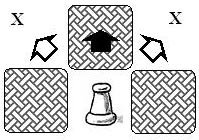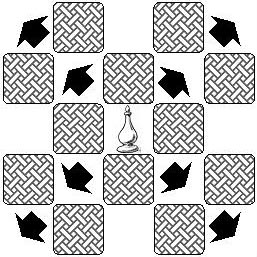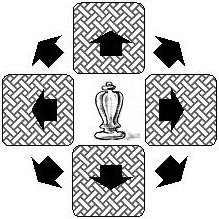How to Play Courier Chess
Download
a free rule booklet ------
Courier Chess Web Site
_
_

Courier
chess thrived in central Europe, especially in Germany, from
the 12th through the 18th century. It was played alongside the
medieval form of chess brought in from the Islamic world, and
persisted well into the modern era, alongside the chess we play
today. Here is a picture of each piece, with its English name, its old German name, and the move it makes on the chessboard. We’ll begin with the pieces more familiar to modern chess players: |
 |
The
King (König) moves one space in
any direction. He does not have the power to castle, and must
always move so that he is not threatened with capture (“in
check”). |
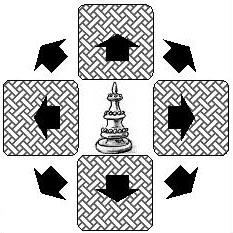
|
 |
The
Rook (Roche) moves as many squares as
it wishes, forward, backward, left or right, until it reaches
another piece, or the end of the board. Exactly like the modern
rook. |
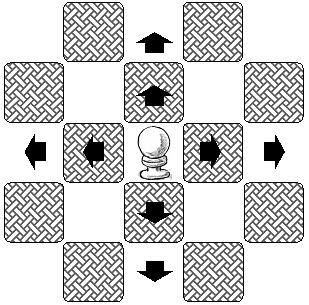 |
 |
The Knight (Reutter) moves in a peculiar L-shape: two spaces forward, backward, right or left, plus one square at a right angle. It can not be blocked by another piece. This move also is exactly like its modern counterpart. |

|
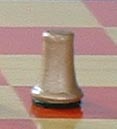 |
The
Pawn (Soldat) moves one space forward,
but captures forward/diagonally, like a modern pawn. It does not
move two spaces forward (except as explained later), and promotes
only to a medieval queen (see following page). |
|
 |
Now
let’s look at some more ancient and unusual pieces and moves.
The Courier
(Kurierer), for which this game was named,
moves exactly like our modern bishop: as many spaces as it wishes
diagonally, but not able to jump over pieces in its way. |
|
 |
The
Medieval Bishop (Schütze) —
not to be confused with the courier — has a move rather
strange to the modern chess player. He moves two spaces diagonally,
no more and no less, and has the power of jumping over a piece
if it stands in his way. This peculiar move can only take him
to 12 possible squares on the entire 8 by 12 chessboard. |
|
 |
The
Medieval Queen (Königin) moves
only one space diagonally. Very different from the modern queen,
but typical of chess before the 16th century. |
|
 |
The
Sage (Man) moves exactly like the king,
but is able to be captured like any other piece. |
|
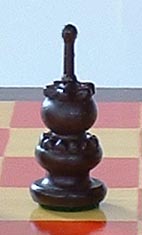 |
The Jester (Schleich) moves only one space forward, backward, left or right.
|
|
The game begins with each player making four peculiar moves: The three pawns in front of the rooks and queen move two spaces forward; the queen also moves two spaces directly forward, to stand right behind the advanced queen pawn. The two players then play alternately, each time moving one piece in accordance with its normal move.
Captures are made by moving a piece onto a square occupied by an enemy piece. All pieces except the pawn (previously described) capture by using their normal moves. If a player’s King is threatened with capture, “check” is declared, and the player must move so that his King is no longer threatened. If there is no possible move to relieve the King of the threat, he is in “checkmate” and the game is over. Even if the King is not in immediate threat, but any possible move would subject him to capture (stalemate), he has lost the game. If a pawn reaches the opposite side of the board, it is immediately promoted, being replaced by a medieval queen (a relatively weak piece). A draw occurs when it can be demonstrated that neither player has sufficient means to win the game. |
Download a free rule booklet ------ See the Courier Chess Web Site
__
HOME
PAGE CHESS PRODUCTS: International | Asian | Reproductions | Unique | Rare | Other Games CHESS HISTORY PAGES: 1 | 2 | 3 | 4 | 5 | 6 | 7 | 8 | 9 | 10 HOW TO PLAY: Chess | Courier Chess | Sittuyin | Xiangqi | Shogi | Shatranj | Janggi Makruk | Shatar | Dou Shou Qi | Luzhanqi LINKS: Chess Variants | Chess History | Chess Articles | Mah Jongg AFFILIATED SITES: Rick Knowlton | Courier Chess | Knowlton Mosaics Ken Knowlton | Insite Age | VerySpecial.us CONTACT US |
